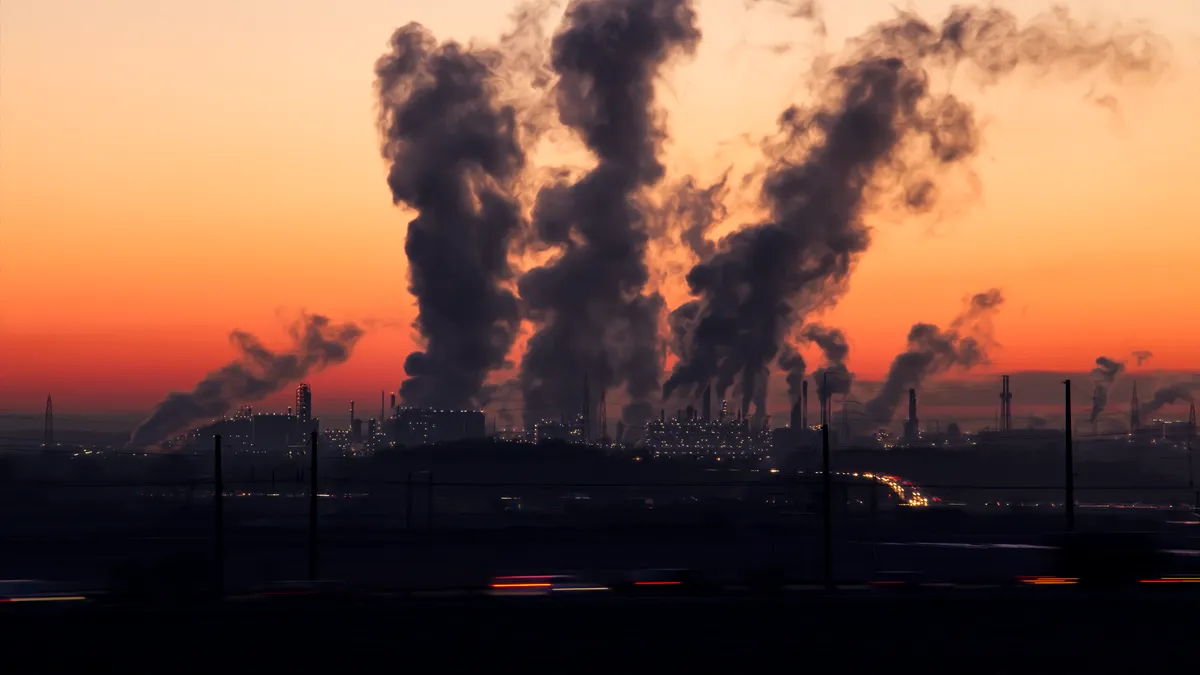UPDATE: Dec. 2, 2020: On Dec. 1, New York Gov. Andrew Cuomo, D, announced the state has adopted new regulations outlining how it will meet lower CO2 limits for its part in the Regional Greenhouse Gas Initiative.
The New York State Department of Environmental Conservation and New York State Energy Research and Development Authority have finalized new rules to achieve the state's portion of a 30% regional cap reduction from 2021 to 2030. The move helps ensure regional emissions are 65% below the 2009 starting levels by 2030.
Dive Brief:
- New York next year intends to include carbon dioxide emissions from gas and oil-fired "peaking" combustion turbines with a generating capacity of less than 25 megawatts in the total annual tonnage of CO2 it will allow power plants to produce.
- New York is one of 10 Mid-Atlantic and New England states participating since 2009 in the Regional Greenhouse Gas Initiative (RGGI). Originally proposed by former New York Gov. George Pataki in 2002, RGGI caps annual regional CO2 emissions by requiring power producers to buy emission allowances for each ton of CO2 produced at prices set in quarterly auctions.
- New York is the last of the 10 RGGI states this year to announce how it will meet the lower CO2 limits set to begin in 2021 and continue with further annual reductions through 2030. The reductions were jointly developed earlier by RGGI member states.
Dive Insight:
The New York State Energy Research and Development Authority (NYSERDA) and the state's Department of Environmental Conservation recently announced the decision to include the emissions of small "peaking" combustion turbines as part of an ambitious plan to clean up dirty air in cities while cutting the state's total current level of CO2 emissions 30% by 2030 and 85% by 2050, compared to 2009 levels.
Details of New York's proposed revisions — including setting aside more funding for disadvantaged communities — will be published in the State Register on May 13 for public comment until July 13. A final decision will be made later this year, according to NYSERDA. There will be no public hearings due to restrictions to limit the spread of COVID-19.
By setting annual CO2 limits, which some power producers initially said would lead to brownouts, New York and other RGGI states have created a market in which carbon has a price. Power producers that generate CO2 have had to include that cost in their business models, convincing some companies to close old plants or run them less often. The market has also encouraged the growth of renewable power and enabled states to create efficiency programs for customers, say state officials and environmental advocates.
RGGI’s 47th quarterly auction, conducted in March, saw 16.2 million allowances sold at a clearing price of $5.65 per ton. Carbon-free power, including wind, solar and nuclear, do not participate in the auctions.
RGGI's annual CO2 emissions cap for the entire region is 96 million tons. Earlier this year, RGGI set the cap at 92.6 million tons for 2021.
But now it appears that In 2021 the cap may actually be larger, said Bruce Ho, a senior advocate at the Natural Resources Defense Council. That's because Virginia is expected to join RGGI next year. And New Jersey, which former Gov. Chris Christie pulled from the group, rejoined earlier this year.
With Virginia's inclusion, the regional cap in 2021 would be reset from the current goal of 92.6 million tons to about 119.8 million tons, said Ho. But the number of tons reduced annually thereafter would also be larger, declining at an annual rate of 3%, instead of the 2.5% annual reductions from 2015 to 2020.
The inclusion of the small combustion turbines is a significant development because they create other pollutants as well as CO2 in already disadvantaged neighborhoods, according to NYSERDA.
Conor Bambrick, director of climate policy for Environmental Advocates of New York, said numbers of the "peakers" have often been co-located in urban areas to meet peak demand.
"I think it’s important that NY is continuing to lead the states in pursuing carbon emissions reductions and it’s equally important that they are willing to go above and beyond by making make sure that disadvantaged communities burdened by pollution are getting clean energy investments that they need," he said. "The dirtiest of the plants that are located in these very same communities are being held to account."













